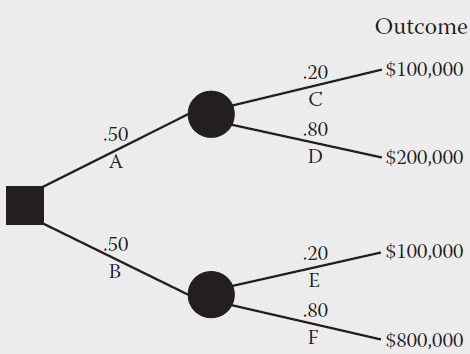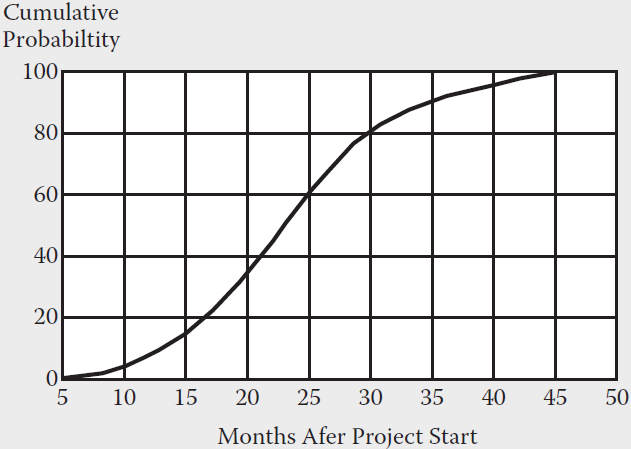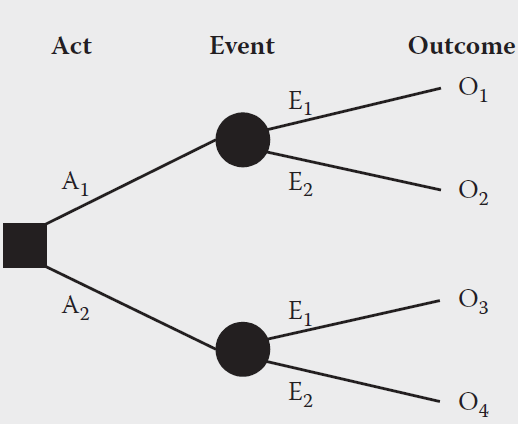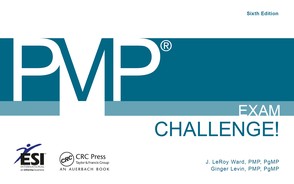Section 8
Project Risk Management
What is Project Risk Management?
ANSWER
The processes concerned with planning, identifying, analyzing, responding, and monitoring and controlling project risk. It also includes maximizing the results of positive events as well as minimizing the consequences of adverse events to project objectives.
[Planning, Monitoring and Controlling]
2 QUESTION
How is Monte Carlo analysis used in schedule simulations?
ANSWER
To “perform” the project many times in order to provide a statistical distribution of the calculated results. For a schedule risk analysis, the schedule network diagram and duration estimates are used.
[Planning]
Generally speaking, in what project phase are risk and opportunity greater, by the widest margin, than the amount at stake?
ANSWER
Concept phase.
[Planning]
4 QUESTION
What is a reserve?
ANSWER
A provision (usually time or money) in the project management plan to mitigate cost and/or schedule risk. Typically, there are two reserves on any project: management reserve and contingency reserve.
[Planning]
What is the purpose of a risk rating in the perform qualitative risk analysis process?
ANSWER
To focus the project team’s efforts on developing responses for those risks that have the highest probability of impact and occurrence.
[Planning]
6 QUESTION
Calculate the probability and expected monetary value (EMV) of path A–C of the figure below.

ANSWER
[Planning]
How is the risk impact scale used?
ANSWER
To identify the severity of each risk’s effect on the project objectives.
[Planning]
8 QUESTION
A project has a 50 percent chance of making a $10,000 profit and a 20 percent chance of losing $50,000. What is the EMV of the project?
ANSWER
[Planning]
What are triggers? What other term can be used to define them? Provide an example.
ANSWER
An indication or warning sign that a risk has occurred or is about to occur.
Risk symptom.
Failure to meet intermediate milestones may be an early warning signal of an impending schedule delay.
[Planning]
10 QUESTION
What is risk mitigation?
ANSWER
A risk response strategy is where the project team acts to reduce the probability of occurrence or impact if the risk. Taking early action to reduce the probability and/or impact of a risk occurring on the project is often more effective than trying to repair the damage after the risk has occurred.
It is a tool and technique in plan risk responses.
[Planning]
What is the purpose of a risk management plan? List five of the ten areas it should include.
ANSWER
To describe to all stakeholders how risk management will be addressed and performed on the project.
Methodology; roles and responsibilities; budgeting; timing; risk categories; definitions of risk probability and impact; probability and impact matrix; revised stakeholder tolerances; reporting formats; and tracking.
[Planning]
12 QUESTION
How can earned value be used in control risks?
ANSWER
To monitor overall project performance by indicating potential deviation of the project at completion from cost and schedule targets. Deviation may indicate the potential impact of threats or opportunities.
[Monitoring and Controlling]
What is risk appetite?
ANSWER
The degree of uncertainty an entity is willing to take on in anticipation of a reward.
[Planning]
14 QUESTION
What is the purpose of reserve analysis?
ANSWER
To compare contingency reserves remaining against risk remaining in order to determine if the remaining reserve is adequate.
[Monitoring and Controlling]
Describe the output from identify risks.
ANSWER
Risk register, which will now include the following initial entries:
- List of identified risks
- List of potential responses
[Planning]
16 QUESTION
What is statistical independence?
ANSWER
The independence of two events in which the occurrence of one is not related to the occurrence of the other.
[Planning]
When is a contingent response strategy used?
ANSWER
Only when certain, previously identified, events occur. Events that trigger the contingency response should be defined and tracked.
[Planning]
18 QUESTION
What are four ways to deflect or transfer a risk?
ANSWER
- Purchase insurance or a performance bond
- Use a warranty
- Use a guarantee
- Use a subcontractor
[Planning]
What is risk acceptance?
ANSWER
Acknowledging a risk but taking no action to avoid, transfer, or mitigate it. Acceptance can be active (for example, preparing a contingency plan) or passive (that is, dealing with the risk if and when it occurs). The risk may be a threat or an opportunity.
[Planning]
20 QUESTION
How are checklists used in risk identification? Provide one advantage and one disadvantage of using a checklist.
ANSWER
To itemize all types of possible risk to the project.
Advantage: Quick and simple.
Disadvantage: Impossible to build an exhaustive checklist.
[Planning]
What are four strategies for dealing with opportunities?
ANSWER
- Exploit
- Share
- Enhance
- Accept
[Planning]
22 QUESTION
During which process are risks prioritized for further analysis or action by assessing and combining their probability of occurrence and impact?
ANSWER
Perform qualitative risk analysis.
[Planning]
What are risk consequences?
ANSWER
The effect on project objectives if the risk event occurs.
[Planning]
24 QUESTION
At which phase(s) in the project life cycle is significant risk thought to have the greatest impact?
ANSWER
Project Execution and Closeout (Termination).
[Planning]
In the following figure, what is the probability that Milestone B will be completed according to schedule, given that activities 1, 2, and 3 each have a 90 percent probability of completion according to schedule?

ANSWER
[Planning]
26 QUESTION
What types of enterprise environmental factors are inputs to identify risks?
ANSWER
- Commercial databases
- Academic studies
- Published checklists
- Benchmarking
- Industry studies
- Risk attitudes
[Planning]
What is a project risk?
ANSWER
An uncertain event that, if it occurs, has a positive or negative effect on at least one project objective, such as time, cost, scope, or quality.
[Planning]
28 QUESTION
What is the difference between a risk and a problem?
ANSWER
A risk is a future phenomenon (or event); it has not yet occurred. A problem, on the other hand, currently exists. Problems are often called issues.
[Planning]
What should you do to avoid a risk?
ANSWER
Adopt an alternative strategy—find another approach to get the job done, which entails changing the project management plan.
[Planning]
30 QUESTION
When should a risk urgency assessment be performed? What are four indicators of priority?
ANSWER
During perform qualitative risk analysis
- Probability of detecting the risk
- Time to effect a risk response
- Symptoms and warning signs
- Risk rating
[Planning]
How are contingency reserves calculated?
ANSWER
Based on the quantitative analysis of the project and the organization’s risk thresholds.
[Planning]
32 QUESTION
What is a risk premium?
ANSWER
Money paid to transfer the risk to a third party.
[Planning]
What is the responsibility of the risk response owner in the control risks process?
ANSWER
To periodically report to the project manager—
- The effectiveness of the risk plan
- Unanticipated effects of the risk under observation
- Any corrective action taken
[Monitoring and Controlling]
34 QUESTION
This figure presents results obtained using what technique?

ANSWER
Monte Carlo simulation of a project schedule.
[Planning]
What is a risk breakdown structure?
ANSWER
A hierarchical depiction of all identified project risks structured by risk category and subcategory that pinpoints the areas and causes of potential risk. It is one of several techniques used in risk management plan.
[Planning]
36 QUESTION
What are four updates from the perform qualitative risk analysis process?
ANSWER
- Assessments of probability and impacts for each risk
- Risk ranking or scores
- Risk urgency information or risk categorization
- Watch list for low probability risks or risks requiring further action
[Planning]
What is used as a model for simulation for a cost risk analysis?
ANSWER
Cost estimates
[Planning]
38 QUESTION
Risk attitudes of the organization and stakeholders can be influenced by three factors, name them.
ANSWER
- Risk appetite
- Risk tolerance
- Risk threshold
[Planning]
Who should attend a meeting to develop the risk management plan?
ANSWER
- Project manager
- Selected project team members
- Anyone in the organization responsible for managing the risk planning and execution activities
- Stakeholders
[Planning]
40 QUESTION
This figure represents what risk quantification technique?

ANSWER
Decision-tree analysis.
[Planning]
When should you avoid a risk? Provide four examples of avoidance.
ANSWER
- When you want to eliminate it.
Examples include:
- Extending the schedule
- Changing the strategy
- Reducing scope
- Shutting down the project entirely
[Planning]
42 QUESTION
What is the output of the perform quantitative risk analysis process?
ANSWER
Project documents updates
[Planning]
How is expected monetary value computed?
ANSWER
Expected monetary value is the product of two numbers: risk event probability (an estimate of the probability that a given risk event will occur) and risk event value (an estimate of the gain or loss that will be incurred if the risk does occur).
[Planning]
44 QUESTION
What does a continuous probability distribution represent? What are two examples?
ANSWER
The uncertainty in values, such as durations of schedule activities and costs of project components.
Beta and triangular distributions.
[Planning]
What are three categories of risk?
ANSWER
- Sources of risk
- The area of the project affected
- Common root causes
[Planning]
46 QUESTION
When should identify risks be performed?
ANSWER
Identify risks is not a one-time event; it should be performed on a regular basis throughout the project.
[Planning]
What is a decision tree? How is it used in perform quantitative risk analysis?
ANSWER
A diagram that shows a decision that is being considered and the implications of choosing one or more available alternatives. The branches of the tree represent either decisions (shown as boxes) or chance events (shown as circles).
Used to compute expected monetary values for each branch of the tree to help the project team quantify each decision alternative.
[Planning]
48 QUESTION
What is a sensitivity analysis? What is a typical display of a sensitivity analysis?
ANSWER
A method used to determine which risks have the greatest potential impact on the project.
Tornado diagram.
[Planning]
Electing to use older technology rather than buying the latest device represents what type of risk response?
ANSWER
Avoidance.
[Planning]
50 QUESTION
How are schedule simulation results used?
ANSWER
To quantify the risk of various schedule alternatives, different project strategies, different paths through the network, or individual activities.
[Planning]
List the six processes in project risk management?
ANSWER
- Plan risk management
- Identify risks
- Perform qualitative risk analysis
- Perform quantitative risk analysis
- Plan risk responses
- Control risks
[Planning and Monitoring and Controlling]
52 QUESTION
What are residual risks?
ANSWER
A risk that remains after responses have been implemented.
[Planning]
What are secondary risks?
ANSWER
Risks that arise after implementing a risk response
[Planning]
54 QUESTION
What is the most common active risk acceptance strategy?
ANSWER
Establishing a contingency reserve, to include amounts of time, money, or resources, to handle the risks, should they occur.
[Planning]
What is the purpose of risk audits? When are they performed?
ANSWER
To assess the effectiveness of the project’s risk management process and to examine and document the effectiveness of planned or unplanned risk responses in dealing with risk occurrences.
Throughout the project life cycle.
[Monitoring and Controlling]
56 QUESTION
For what category of risk would you use the “exploit” strategy?
ANSWER
For positive risks or opportunities.
[Planning]
What is a SWOT analysis? How is it used?
ANSWER
A strengths, weaknesses, opportunities, and threats analysis.
Used in identify risks, it tends to increase the number of project risks considered.
[Planning]
58 QUESTION
What is an assumptions analysis? How is it used?
ANSWER
An examination of the validity of assumptions as they apply to the project.
Used in identify risks to identify risks by examining the inaccuracy, inconsistency, or instability or incompleteness of assumptions. Assumptions are tested during perform qualitative risk analysis.
[Planning]
What action should the project manager take to ensure that each risk response is implemented and monitored?
ANSWER
Identify and assign an individual to own each risk who will take personal responsibility for protecting the project objectives from the risk’s impact.
[Planning]
60 QUESTION
What are three examples of risk diagramming techniques?
ANSWER
- Cause-and-effect diagrams
- Systems or process flowcharts
- Influence diagrams
[Planning]
